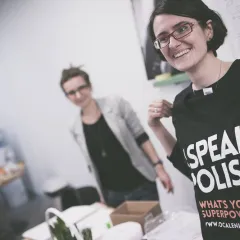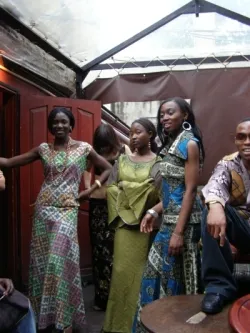Magic and alluring powder! This is how henna is called in Sahel ( the area along the south borders of Sahara ). In Dakar, during a warm rainy season when beaches are crowded, girls make a real fashion show. Like everywhere else in the world they try to beautify themselves in all the possible ways. During the carnaval, „reducing” seems to be the easiest way. That is choosing the simplest clothes. In the streets of Bamako, you can admire shiny smoky eyes or glittering lips. In a nutshell – French cosmetics available in Warsaw shops. In large African cities professional beauty salons offer permanent make-up. In the country time goes slowly – townsmen say it's quite boring there. I think that getting used to this monotonny will be welcome. Sun rises monotonously. And what? Fashion is more conservative here but it doesn't mean that women don't show their beauty. Here modesty and discretion are the rule.
Beautifying is important in every culture. And usually one spends much time doing it. So is the case in Sahel. Let us imagine somebody dealing with women's feet and hands. And now a little guess : it's neither manicure nor pedicure. What takes so much time when it comes to beautifying? Henna, of course!! Even camels in Sahel know it. During the session, hands and feet are artistically decorated with brown patterns. They can be very dark if a woman wants to stand out. For example Fulani women have brighter carnation in comparison with other inhabitants of subsaharian Africa.
So henna, in contrast to the carnation, emphasize their beauty.
Skin dying is an old tradition in the region. During various family ceremonies, especially weddings, people used to dye fabrics, hands and feet. Nothing changed. Women still use henna, which is fundamental to good appearance. It beautifies and gives self-confidence, that's why patterns are the thing you may boast of. Time spent on doing henna, precision and beauty of motives on your hands and feet – all that is visible to men. These patterns put all the bans and cultural taboos aside. Henna is a discreet form of seducing.
Henna is called a temporary tattoo because it endures up to three weeks. Women make the dye by themselves. They add two spoons of powdered leaves and the mixture made of a spoon of lemon juice and rose water into the glass of water. Lemon juice may be replaced by oil to make tattoo stay longer. After mixing you get the homogenous paste ready to be used. It should remain on the skin after the first use. Some women cook it or add sugar. Anyway, when the dye is prepared, there is a short two or three minutes' break and then dying starts. The paste have to be used quickly because it loses its quality. A small wooden stick is used. When dying ends hands and feet are covered with a plastic foil or a sock which helps to keep warmth and humidity.
Henna is popular with Sahel women from a Muslim region, so it has its adversaries. They think that henna makes ritual ablution before the prayer impossible.
Henna is reported to have played an important esthetic and religious role in ancient Egypt and Mesopotamia. In the countries like China and Vietnam women dye their nails in this way. Henna came to Maghreb and subsaharian Africa with Islamic invasions. These countries were Mali, Senegal and Niger.
In Maghreb like in Africa men can easily decipher the message brought by henna. It's the sign of finesse, love signal, a call to pleasure and even a promise of happiness. It is an appeal for passion in the countries where decency is strongly, not to say strictly – recommended by the opposite sex. But like everywhere else erotics has its ways to make an everyday walk in the street acceptable.
When the henna is talked about, there comes the question of mens' sexual behaviour. It's very close to animal wildness.Henna and sex! Strong exciting scent brings to mind mating season and women say there is nothing embarrassing about it. Just the opposite, it's a pure beauty.!
Henna has its own erotic symbolics. Traditionally it is treated as a sign of desire and sex. Discretion, code language, sensual body play. Today it's a sign language of Maghreb – each part of the body has its meaning – buttocks ( desire for sex ), arms ( desire for tenderness ), belly ( desire for motherhood ).
Many young people, especially in the West and Brasil, choose henna because they are enchanted by the beauty of its patterns but most of all by its short duration. That's the end of painful tattooing that remains forever. It's the biggest advantage. Classic tattoo patterns are visible for a fortnight or so, and may be changed many times if you want. For European beauty salons it has long been well known.
Text by Mamadou Diouf.
Translated by Agata Bogucka.

















